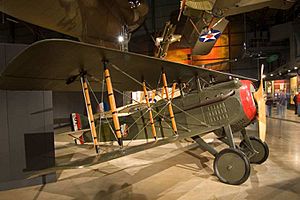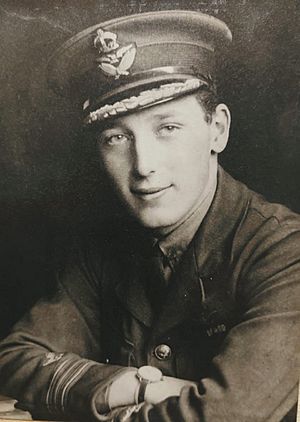William Kennedy-Cochran-Patrick facts for kids
Quick facts for kids
William John Charles Kennedy-Cochran-Patrick
|
|
|---|---|
| Born | 25 May 1896 Beith, Ayrshire, Scotland |
| Died | 26 September 1933 (aged 37) Baragwanath Airport, Johannesburg, South Africa |
| Allegiance | |
| Service/ |
|
| Years of service | 1915–1919 |
| Rank | Major |
| Unit | The Rifle Brigade Royal Flying Corps
|
| Commands held | No. 60 Squadron |
| Battles/wars | First World War |
| Awards | Distinguished Service Order, Military Cross & Bar |
| Other work | Aerial surveys in South America, Burma, Iraq, and Africa |
William John Charles Kennedy-Cochran-Patrick, born in Scotland in 1896, was a brave pilot during the First World War. He was known as a 'flying ace' because he shot down 21 enemy airplanes! He was especially good at flying the Spad VII fighter plane. After the war, he used his flying skills to map out large areas of land from the sky all over the world.
Contents
A Sky Hero: William Kennedy-Cochran-Patrick
Early Life and Training
William Kennedy-Cochran-Patrick was born in Beith, Ayrshire, Scotland, on May 25, 1896. He was the only son in his family, with three younger sisters.
He went to school at Wellington College and later studied at Trinity College, Cambridge. After that, he trained to become an officer at the Royal Military College, Sandhurst.
Flying High in World War I
William became a qualified pilot in April 1915. He was so good at flying that he was chosen to be the main test pilot at No. 1 Aeroplane Depot in France. This meant he would fly new planes to make sure they worked correctly. He officially joined the Royal Flying Corps (RFC) on June 11, 1915.
First Victories and Awards
On March 17, 1916, William was promoted to lieutenant. Even though he was a test pilot, he achieved his first victory on April 26. He flew a Nieuport plane and attacked an enemy LVG C-type plane three times. The enemy plane crashed, and its crew died. For this brave act, he was given the Military Cross award on May 16, 1916.
After his first victory and award, he joined No. 70 Squadron. He flew Sopwith 1½ Strutter planes and scored two more victories in September 1916. Sadly, his observer (the person who helped him spot enemies) was killed during both of these flights.
Ace Pilot in the SPAD VII

In early 1917, William was promoted to captain and moved to No. 23 Squadron. Here, he flew the fast Spad VII planes. On April 22, he shot down two enemy planes in one day, which made him a 'flying ace' (a pilot with five or more victories). He won two more times in April and again on May 2.
His most famous victory happened on May 11. He shot down an Albatros D.III plane flown by a German ace pilot named Edmund Nathanael. William's attack set the plane on fire, and it crashed to the ground.
Around this time, a very important general, Major General Hugh Trenchard, trusted William to test a new plane called the Spad XIII. William gave his report to Trenchard on May 1, 1917.
William continued to have many victories. He claimed three more in May, four in June, and five in July. After his last victory on July 16, 1917, he was promoted to acting Major on July 22. He was then given command of No. 60 Squadron.
Leading a Squadron
Because of his continued bravery, William received a Bar to his Military Cross on August 14, 1917. This meant he had earned the award a second time. A month later, on September 17, he was given the Distinguished Service Order, another very important award for his courage.
On November 7, 1917, Field Marshal Sir Douglas Haig mentioned William in his official reports. This was a special recognition for his excellent work.
At the end of 1917, William was sent back to England to help with pilot training. In 1918, he returned to No. 1 Aeroplane Depot. During the war, he was credited with capturing one enemy plane, destroying six, sharing four destructions, and making nine planes go 'out of control' (and one shared).
After the War: Mapping the World
William left the military on July 9, 1919. He became a major in the General Reserve of Officers on the same day.
On July 20, 1924, he married Natalie Bertha Tanner. They had one son, Neil, two years later.
After the war, William used his flying skills for a new kind of work: aerial surveys. This means flying over land to take pictures and create maps from the sky. He did this work in South America, Burma, Iraq, and Africa. He even started his own company, The Aircraft Operating Company of South Africa Pty Ltd. He had a big contract to survey 20,000 square miles (about 52,000 square kilometers) for an air route in Northern Rhodesia (which is now Zambia).
He became a member of the Royal Aero Club on December 10, 1930.
His Final Flight
Sadly, on September 26, 1933, William took off from Baragwanath Airport near Johannesburg, South Africa. He was flying a de Havilland DH.84 Dragon plane. The plane lost speed and control at about 250 feet (76 meters) after making a sharp turn. The plane crashed, and William and his passenger, Sir Michael Oppenheimer, both died.
Awards and Recognition
William Kennedy-Cochran-Patrick received several important awards for his bravery and skill:
Military Cross (MC) This award was given to him for his amazing skill and determination.
2nd Lt. William John Charles Kennedy-Cochran-Patrick, Rif. Brig, and R.F.C.
For conspicuous skill and determination. He climbed and attacked an enemy machine at 14,000 feet and, although he failed in his first and second attacks, he went for it again a third time, shot both pilot and observer and brought it down. He followed it down and landed alongside.
Military Cross (MC) Bar He received a Bar, meaning a second Military Cross, for his outstanding bravery in attacking enemy aircraft.
Lt. (T./Capt.) William John Charles Kennedy-Cochran-Patrick, M.C., Rif. Bde. and R.F.C.
For conspicuous gallantry in attacking hostile aircraft. Within two months he brought down two hostile machines in flames, and four others completely out of control. In addition, he has driven several others down in a damaged condition.
Distinguished Service Order (DSO) This high honor was given to him for his great courage and dedication in destroying enemy planes.
Lt. (T./Capt.) William John Charles Kennedy-Cochran-Patrick, M.C., Bif. Bde. and R.F.C.
For conspicuous gallantry and devotion to duty on numerous occasions in destroying and driving down hostile machines, frequently engaging the enemy with great dash and a fine offensive spirit when encountered in superior numbers. By his cool judgment and splendid fearlessness he has instilled confidence in all around him, his brilliant leadership being chiefly responsible for his numerous successes.


